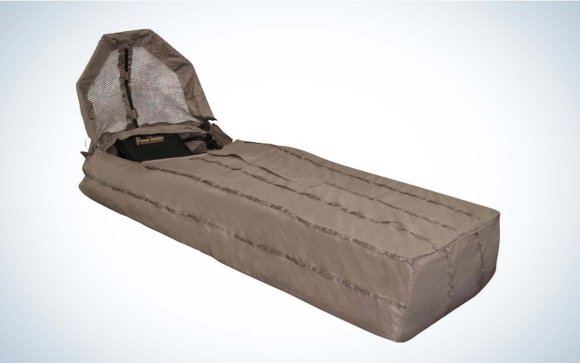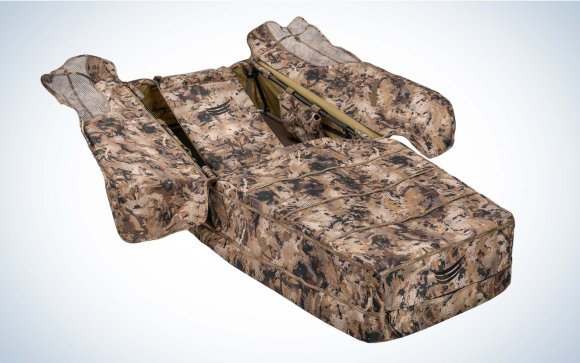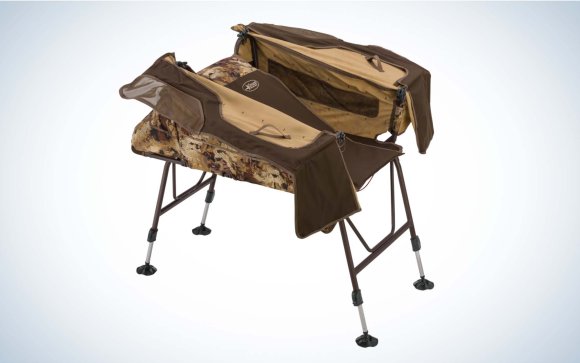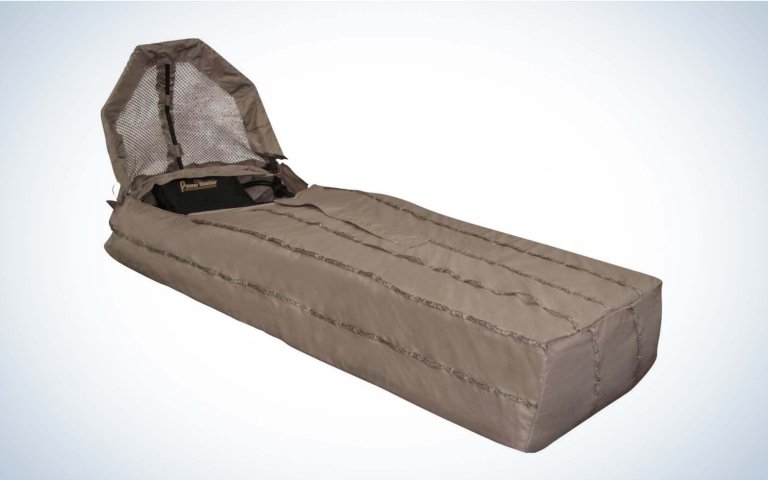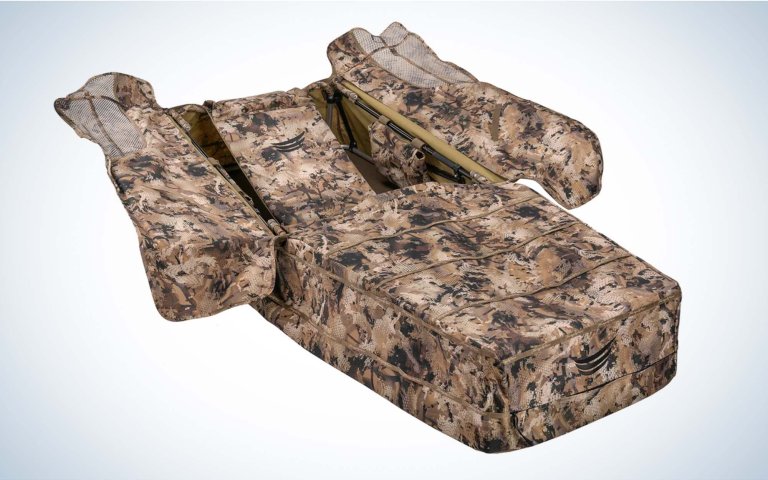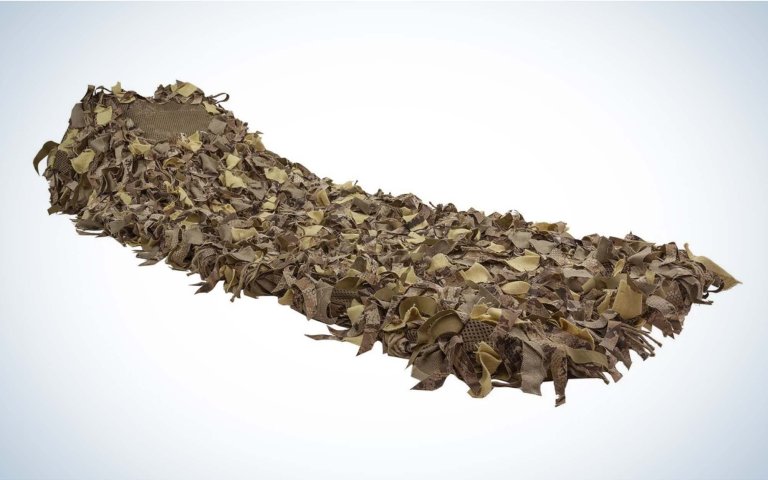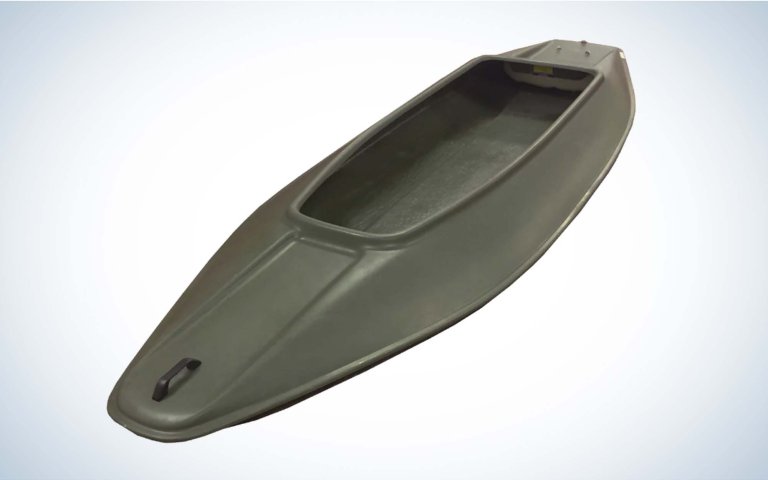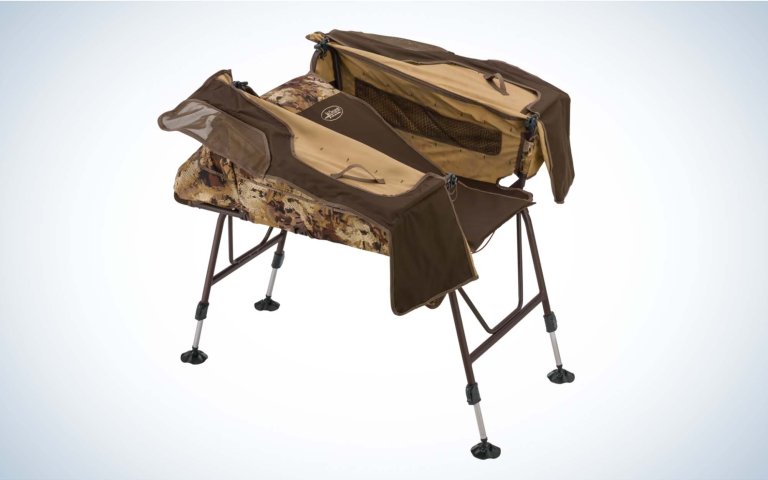We may earn revenue from the products available on this page and participate in affiliate programs. Learn More ›
Imagine a giant flock—we’re talking 1,000 or more—of lesser Canada geese making the final hook into the wind and descending into the decoy spread, the first few landing right at your feet. That’s what it’s like hunting in a layout blind.
It’s an experience you’ll want to do over and over again every fall, wishing the season never ends. But to “live” amongst the flocks of ducks and geese, you have to have the right gear. That includes a suitable layout blind for the species you’re after and the location you’re pursuing them in. Whether it’s mallards in the marsh or snows on the prairie, there is a layout built for the hunt at hand. To help you find the right blind, I’ve chosen the best layout blinds for fields, boats, and water across a range of budgets. Here are my picks.
- Best Budget: Avery Power Hunter
- Best Full-Size Field: Tanglefree Flight Series Snap Blind
- Best Layout For Concealment: Lucky Duck Goose Chair Combo
- Best Low-Profile Layout: Tanglefree Swag Blind
- Best Layout Boat: MOMarsh Fatboy DP Combo
- Best for Water Hunts: MOMarsh Invisi-Man
How We Chose the Best Layout Blinds

I’ve hunted out of just about every layout blind there is. Most coffin-style layout blinds (the ones with two doors you pop open when birds are in shotgun range) are the same. Some use a locking pin system, while others may have sliding bars to keep the frame in place while you hunt. The blind dimensions can be slightly different, as can the amenities, such as internal pockets, goose flag holders, and more. But at a basic level, almost all are conceptualized based on Ron Latschaw’s 1993 design of the Final Approach Eliminator. So, if you’ve hunted in one coffin-style layout, you have pretty much hunted out of them all. I have spent time in dozens of these blinds.
Once you go outside conventional layouts, there are several back-board or mat-style blinds that are essentially a more comfortable way to lay on the ground while staying concealed.
Tanglefree, Lucky Duck, and MoMarsh all do this well with their blinds and chairs. And MoMarsh has probably taken layout hunting to its highest level. Founder Ira McCauley engineered blinds with telescopic legs, so you can hunt in up to 30 inches of water from a layout. And his Fatboy DP is likely the most inventive one-man boat blind you and your retriever will ever hunt from.
Best Layout Blinds: Reviews and Recommendations
Best Budget: Avery Power Hunter
Pros
- Lightweight
- Quick setup/takedown
- Incredibly simple blind
Cons
- Visibility is limited due to the hood
- Not much padding in the backrest
Key Features
- Weight: 11 pounds
- Extremely low profile
- Folds into a 32 x 33 x 4-inch backpack
- Adjustable shoulder straps
- Aluminum frame and hinges
- Flip top makes it easier to call and shoot
- Camo mesh top and rear windows
- Seven rows of stubble straps
- Snow cover sold separately
- Price: $180
The Power Hunter is basically a sleeping bag with a backrest and hood to keep you concealed. To set up the layout, you simply unfold it, lay it on the ground, then reach inside and push an aluminum bar backwards. Instead of flip-open doors, there is a mesh flip top that can be pushed open when birds are in shooting range. The hood can be brushed in, but you do need to leave spaces open so you can see. Visibility is somewhat limited, especially if you are trying to look behind the blind. But because there is no frame in the foot bag, you can roll to your side for better visuals. Stubble straps do an OK job of keeping brush-in materials where you want them to be. If you take your time and really load up the straps, less chaff will fall out. The low profile of the Power Hunter allows you to hide just about anywhere. And because they are so simple, the blinds tend to last forever. In fact, a Power Hunter we bought more than 15 years ago is still hanging in the garage.
Read Next: Best Duck Calls
Best Full Size Field: Tanglefree Flight Series Snap Blind
Pros
- No pins
- Roomy interior
- Low profile
- Lightweight frame
Cons
- Boot bag is a tight fit for bigger hunters
- No snow goose cover option
Key Features
- Size: 83 x 37.5 x 16 inches
- Weighs 19.5 pounds
- Snaps together without pins
- Constructed of 600D material
- Mesh face panel
- Padded, adjustable backrest
- Zippered flagging ports
- Adjustable backpack straps
- Two adjustable/removable shell pouches
- Metal buckles
- Drag handle
- Available in Optifade Marsh
- Price: $370
Instead of steel pins, which can be difficult to insert with cold fingers on frosty mornings. Tanglefree uses four snaps to hold the aluminum frame of the Flight Series layout blind in place. The snap system is more convenient and faster for assembly and breakdown of the blind. It has a spacious interior (37.5-inches wide), and the backrest is padded for maximum comfort. There’s even a little pillow to rest your head on for all-day grinds. Because the layout is just 16-inches tall, it can be slightly uncomfortable for large-bodied hunters. The bar that holds up the boot bag in place doesn’t give you much room to slide your legs in if they happen to be as thick as oaks. But the blind’s low profile helps with concealment. There are two storage bags along the rails of the layout that slide, so you can adjust them depending on your length of reach. The exterior of the blind is covered in a durable 600D material, and Tanglefree made the stubble straps on the boot bag horizontal so that it keeps brush in place.

Best Low-Profile: Tanglefree Swag Blind
Pros
- Ghillie blanket eliminates blind brushing
- Easy to set up/breakdown
- Low profile
- Hide right in the decoys
Cons
- No protection from the elements
Key Features
- Weight: 9.5 pounds
- Optifade Marsh padded backrest (60-inches long x 19-inches wide)
- Head adjusts from 12.5 to 17 inches
- Swag blanket available in Optifade Marsh and Timber, plus Snow (built-in mesh calling window)
- No assembly required
- Price: $290
Guides Christian Locke and Baylor Parker (and their crew at Kansas Hurt Locker) were responsible for the development of the Swag Blind after they started hunting lesser Canadas from Tanglefree’s Ghost Blinds and using store-bought ghillie blankets to hide clients in a sea of silhouettes and windsocks.
Tanglefree made it easier on the consumer by consolidating the backrest and ghillie into the Swag Blind, opting to include a mesh calling window so hunters can see birds working and know when to call the shot. The backrest sets up in seconds, and the headrest is adjustable from 12.5 to 17 inches. There is no need to brush in the blind, but you can throw cut crops on top of the ghillie blanket to blend in better. Tanglefree offers three blanket colors—Optifade Marsh and Timber, plus Snow—so you can hide in a variety of habitats. Swag Blinds can be used to hunt big geese as well if you keep hunting parties small. They are great for public duck hunters who need to hide on levee banks without much cover. In any situation where the cover is thin, this blind excels.

Best for Concealment: Lucky Duck Goose Chair Combo
Pros
- Decoy hood allows you to hunt in the spread
- Hiding in short cover is possible
- No need to brush the blind
- The mesh hood can swapped in for the decoy
Cons
- Decoy has too many view slots
Key Features
- Oversized Canada goose shell with view slots
- Decoy features a removable flocked head
- Padded seat and pillow
- Tan blanket
- Mesh hood cover
- The backrest is made of a PVC-coated mesh to stay dry
- Shoulder straps for easy transport
- Snow cover sold separately
- Price: $330
Using an oversized goose shell to hide in the decoys is not a new tactic, but Lucky Duck is the first to conceptualize it into a layout blind. Big honkers can often pick out traditional coffin blinds in the middle of a cut cornfield. This layout, even though it may look a little ridiculous, will keep you concealed and pique the interest of wary Canada geese (due to the massive size of the shell). Both will result in getting honkers in close.
Lucky Duck includes a separate mesh hood with the blind and a tan blanket that you can brush in. We typically don’t use the blanket, opting instead to rake up chaff or cut cedar tree limbs to cover our legs up. The seat is padded with a small pillow to rest your head on. A PVC-coated mesh backing will keep you dry. Our only complaint is that there are too many viewing slots cut into the shell of the decoy. It’s nice to be able to see more of your surroundings, but one cut-out in the middle of the shell would have sufficed. Wearing a black hooded sweatshirt or jacket will help fill in all those open slots so birds don’t spook on approach.
Read Next: Best Duck Hunting Shotguns
Best Layout Boat: MoMarsh Fatboy DP Combo
Pros
- Capable of hunting a variety of environments other hunters can’t get to
- Removable transom
- Combo kit makes it a snap to brush in
- Hull design makes for a smooth ride
- Fits in the bed of your truck
Cons
- Limited stock
- Not a great choice for rough water
Key Features
- Size: 13 feet x 44 inches x 13 inches
- Weight: 95 pounds
- Capacity: 370 pounds
- Max horsepower: 2 hp
- Designed for stability, shallow draft
- Screw in the plug for easy draining.
- Optional detachable transom for gas or electric motor
- Stable enough to stand while polling or paddling
- Displacement hull to cut through water with little propulsion
- Price: $3,000
Whether you hunt shallow marshes or big water, the Momarsh Fatboy DP Combo is an awesome tool to have at your disposal. Small enough to transport in the bed of your truck (or roof rack), the Fatboy DP has a removable transom that you can use a trolling motor or outboard with if the upright of the transom is towards the stern. Flip it around, and that allows you to use a heavier mud motor, bringing more weight forward so the boat balances evenly. The cockpit is 7 feet long and 29 inches wide, so there is plenty of room to lie down and stay hidden while hunting. You may want to buy an Invisilounge, a closed-cell five-position ratcheting seat, or something similar to optimize comfort. There is also a spot for your dog to sit in the rear of the cockpit.
The hand-laid fiberglass Fatboy DP is a great option for hunters who want to get away from the crowds. You can walk it into shallow waters that a bigger, heavier boat cannot get to. And if you need to portage the Fatboy DP over a sandbar or levee, it’s doable. The boat’s custom fit cover makes it much simpler to brush in, though an inventive hunter can create their own concealment system. The only limits you will face with this layout are the amount of weight it can carry (370 pounds) and its ability to perform in rough waters. You don’t want to be on a big lake or flowage in a 95-pound boat when the wind kicks up and creates a big chop.
Best for Water Hunts: MOMarsh Invisi-Man
Pros
- It’s the only layout blind you can hunt in up to 30 inches of water
- Easy to get into and out of, no matter your size
- It folds up so you can stack multiple blinds in transit
- No foot bag
Cons
- Heavy
Key Features
- Folding and adjustable legs from 0 to 30 inches
- Built-in back straps
- Weight: 27 pounds
- Weight limit: 300 pounds
- Four-pin door system
- Doors are adjustable for height
- Available in Mossy Oak Bottomland, Optifade Timber, and Marsh
- Price: $380
MOMarsh’s Invisi-Man is an evolution of the ATX Invisilay, which is basically a layout blind with four individually adjustable legs that allow you to hunt in almost 3 feet of water. The Invisi-Man doesn’t have a foot bag, which makes it easier for big fellas to climb in and out. As a result, your feet dangle in the water, so you can also add motion to the decoys by kicking the water just like flooded timber hunters do on windless days. Each leg has a cleat at the bottom to keep the blind from sinking into the marsh. To adjust the legs, there are four plastic clips at the base of the frame. Internal pockets give you a place to stash shells and hold drinks, plus there is a zippered pouch on the outside to store dead birds. Doors can be raised or lowered to your desired height by twisting two rubber-headed screws that slide into the top of the frame. The legs fold up as well, so you can hunt dry ground.

FAQs
Every new layout blind needs to have the shine knocked off it. To do that, put some dirt in a bucket, add water, find an old kitchen broom, and coat the exterior with mud. You can also use brown or tan spray paint; just make sure it’s flat and not the high gloss finish. That won’t take you more than 15 minutes. Brushing a layout can take as long as you want it to, but give yourself at least 45 minutes to an hour before the first hunt of the season to get it grassed in. The smart play is to brush the layout before you hunt and have it ready to go. Cut tall grasses (there are many synthetic versions you can buy as well) that will blend in with the area you’re hunting. While you’re setting up for the morning of the hunt, use whatever chaff is on the ground to make your blind look natural. If you’re really ambitious, go to your hunting spot before the hunt and bag up the material you want to use to brush the blind.
There’s no set amount of time a layout will last. If you pull a trailer and never have to break down your blind after a hunt, it may never give out, even if you hunt every day of the season (unless the mice decide to use it as a nest in the spring and summer). Like any tool, the more you use a layout, the more likely it is to fail. So mobile hunters, who have to fold up their layout and re-deploy it a lot, are going to be buying new layouts more often. That said, the average hunter should expect to get somewhere between three to five years from a solidly-built blind.
If you are a healthy, average-sized man or woman, you won’t struggle one bit to get into and out of a traditional coffin-style layout blind. And we have seen plenty of folks fall asleep in a layout waiting for the sunrise (we may have taken a siesta or two ourselves), so they are plenty comfortable. But if you are big or tall (or both), layouts are not going to be your favorite blind to hunt from. Once you are in most of them, it’s typically fine—unless you’re taller than 6-foot-4—but getting in and out is a bit of a chore. If you’re built like an offensive lineman, it can be a struggle to sit up and shoot too. We have seen an entire blind come up with a hunter (who actually played college football) when a group of snows did it right in Arkansas several years ago. It’s also difficult for older hunters to go from their backs to a sitting position and shoot. Beavertail once tried a spring-loaded seat in its layout to mitigate this issue. It didn’t catch on—the blinds were too big and heavy.
The brands that manufacture these blinds have to consider the profile of the blind. The smaller it is, the less likely ducks and geese are to pick you out and the less storage space it takes up in the trailer. Some companies have tried to build layouts the size of Cadillacs in the past, and they never last long. Sure, they are comfortable for people of every size to hunt from, but they also stick out like a snow goose in a flock full of Canada geese.
Final Thoughts on the Best Layout Blinds
You may not see many folks hunting from traditional layout blinds in the middle of a cut ag field anymore—waterfowl (geese in particular) have become wise to a row of 10 layouts stacked next to one another in cut corn. But that doesn’t mean you can’t still get in the decoys and kill birds. The key is staying concealed and making your blind look as natural as possible. To do that, you need to spend extra time brushing in layouts, positioning decoys in the right spots, and using the sun and wind to your advantage.
And there is still a place for traditional layouts. Hunting field edges and center pivots from A-frames became ultra popular again in the early 2000s. As waterfowl smartened up, hunters brought the layouts back, using them to hunt from hedgerows and fencelines, proving Ron Latschaw’s layout design remains timeless.
- Best Budget: Avery Power Hunter
- Best Full-Size Field: Tanglefree Flight Series Snap Blind
- Best Layout For Concealment: Lucky Duck Goose Chair Combo
- Best Low-Profile Layout: Tanglefree Swag Blind
- Best Layout Boat: MOMarsh Fatboy DP Combo
- Best for Water Hunts: MOMarsh Invisiman

